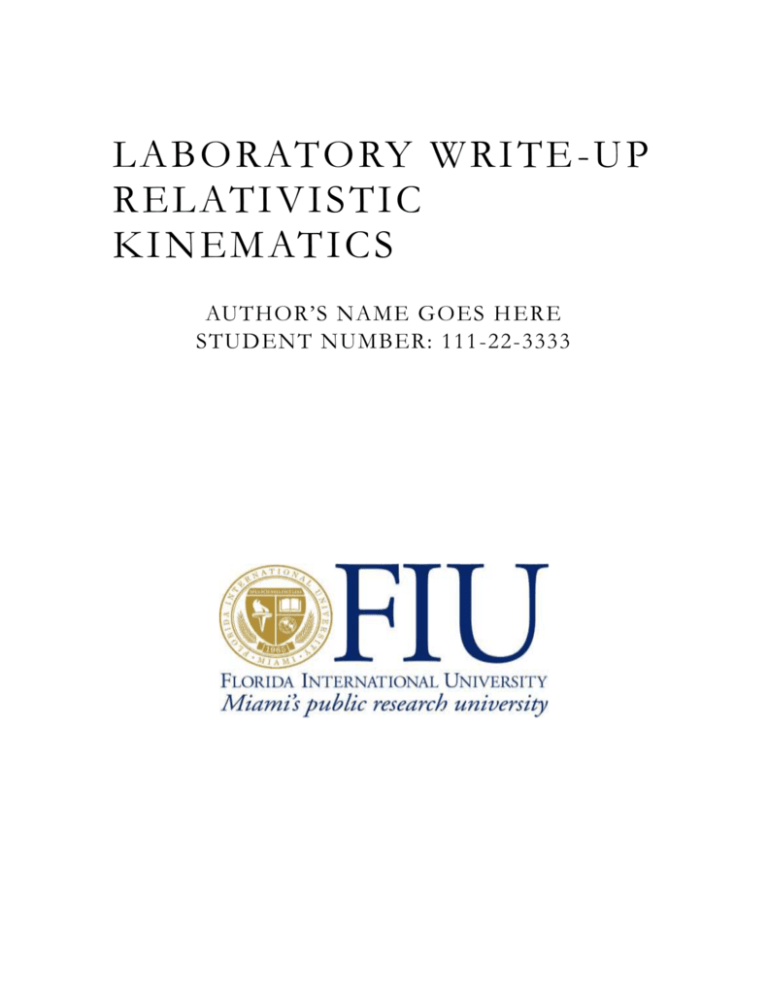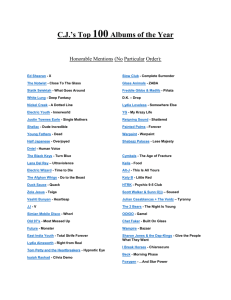07-SpaceTime
advertisement

LA BO RATORY WR I TE -U P R E L ATI V I S TIC K I N EM ATI CS AUTHOR’S NAME GOES H ERE STUDENT NUMBER: 111 -22-3333 RELATIV ISTIC KI NEMAT ICS 1 . P U R P OS E Introduction In this experiment, you will be using several interactive computer programs, Java applets, to examine a number of consequences of the Special Theory of Relativity. Although the programs are based on the Theory, it is instructive to regard it as an experimental system from which results can be obtained for comparison with theoretical predictions. The applets were originally developed to teach physics with at Davidson College by Wolfgang Christian and Mario Belloni. If you want more information, you can also visit their website at: http://webphysics.davidson.edu/physletprob for help. Displays The three screens illustrate the central points of special relativity: time dilation (time passes more slowly in a moving frame of referenced), length contraction (moving objects are shortened along the axis of their movement when viewed in another frame of reference), and simultaneity (whether or not it is possible for two distinct events to appear to have occurred a the same time). Theory Special relativity is based on two postulates: 1) The laws of physics are the same in all inertial reference frames and 2) The speed of light in a vacuum has the same value in all inertial reference frames. These lead to the Lorentz coordinate and velocity transformations that include the following: x' = (x - vt) ............(1) t' = (t - vx/c2) ............(2) u’x = (ux - v)/(1 – uxv/c2) ............(3) where 2= 1/(1 - v2/c2) The inverse equations are obtained by interchanging primed and unprimed symbols, and altering the sign of v where it appears. Equations 1 and 2, in turn, lead to length contraction, time dilation, and the concept of simultaneity. Length contraction: To an observer at rest in some reference frame, the length of a moving object along the direction of motion is contracted by a factor compared to its "rest length". Time dilation: To an observer at rest in some reference frame, a moving clock runs more slowly by a factor -1 than an identical clock which is at rest in the reference frame. Simultaneity: Two events that are simultaneous in one reference frame are generally not simultaneous in a second reference frame that is moving with respect to the first. 2. PROCEDURE Familiarization: Use a web browser and go to http://webphysics.davidson.edu/physletprob/. Click “Ch 10: Modern”. You’ll use the various physlets on this page to work your exercises. Length contraction and time dilation: Open the web page called “Time Dilation”. You will see a red rectangle (simulating a space ship) and a green vertical “space beacon”. The moving red rectangle simulates a space ship. The space beacon emits a light flash when each end passes by. 2 Question 1a: A spaceship (red) flies close to a space beacon (green) at 70% of the speed of light. The beacon emits light flashes as shown in the animation. The time shown in the upper left hand corner is the time as measured in the reference frame of the beacon. Click-drag to measure the size of objects in meters. What is the time difference between these light flashes as seen by the crew inside the space ship? Question 1b What is the length of the spaceship as measured by the crew of the spaceship? Reference Frames: Open “Reference Frames”. A moving red rectangle simulates a space ship passing directly over another space ship, a green rectangle. A light flash occurs when the left sides coincide and again when the right sides coincide. Answer the following questions, being sure to first explore the applet by varying the relative velocity and the frame of reference. Question 2 Two measuring sticks pass close by each other with relative speeds comparable to the speed of light. A light flash occurs when the right ends of the sticks coincide, event 1, and again when the left ends coincide, event 2. Which of the following is true for all relative velocities? State why. You can view the events in either the green reference frame or the red reference frame. a. There is a unique speed when the events are simultaneous in both reference frames. b. Event 1 always occurs before event 2. c. At a given speed, both the red and green observers will always agree on which event occurred first. d. None of the above. Time dilation and the Twin Paradox: Open “Twin Paradox”. Students can be easily confused by the effect of transit time in the twin paradox. Unlike Minkowski diagrams, this stimulation explicitly shows what the earth-bound twin sees by adding and subtracting the transit time to the display. The animation has 3 moving dots. The black dot corresponds to the Earthbound twin. The leading green dot gives the simultaneous (according to Earth) position of the traveling twin. The trailing red dot, which will change to blue, indicates what the Earthbound twin actually sees. (The color change represents the Doppler shift as the earthbound twin looks at his brother.) It lags the other red dot on the outbound leg, as the image of the traveling twin received by the Earthbound twin is late due to the light travel time. On the return leg, this dot turns blue and rapidly catches up to the green dot. The clock on the left shows proper time for the Earthbound observer. It moves at a constant rate, with one full rotation corresponding to one grid spacing on the time axis of the diagram. The middle clock corresponds to the leading green dot. This is the time in the twin's frame of reference and is time-dilated according to special theory of relativity. The clock on the right shows what the Earthbound observer would actually see through a telescope focused on his traveling twin's clock. This time takes into account both the relativistic Doppler effect and the light travel time. If the earthbound twin were to subtract the light travel time from these readings, he would obtain the values shown in the second clock. Note that it is slow up until almost the very end, when it speeds up as the blue-shifted signals from the traveling twin begin to arrive back at Earth. 3 To the left of each clock is a time bar, indicating the total number of rotations of the clock, i.e., the age. The leftmost bar shows the age of the Earthbound twin, the middle bar gives the simultaneous (according to Earth) age of the traveling twin, and the rightmost bar gives the age of the traveling twin as viewed by the Earthbound twin through his telescope. Question 3. Show you work as you answer the following: How fast is the moving twin traveling? Assume time is measured in years and distance is measured in light years. What is the age difference between the twins when they reunite? How can you convert the readings from the third clock to the second clock? Some dots follow world lines in the diagram, others do not. Which dots follow world lines? 3 . C O N C L U S I ON S State the conclusions you reached from this lab. 4







